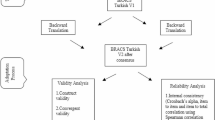Abstract
Very few published studies have reported auditory speech perception in Hindi children with pre-lingual hearing loss. The study is aimed at comparing the speech perception skills of Hindi speaking children with pre-lingual severe to profound hearing loss using hearing aids and cochlear implants. Forty-three 6 to 8-year old children were included as participants, of which 22 were bilateral behind-the-ear hearing aid (HA) users and 21 were unilateral cochlear implant (CI) users. Speech perception was assessed through a forced-choice, picture-pointing task using recorded stimuli presented at 70 dB HL in the sound field. The skills assessed include: (a) pattern perception, (b) bisyllabic word identification, (c) monosyllabic word identification, (d) sentence identification and (e) minimal pair identification. Children using CI consistently performed significantly better than those with HA on all tasks. For the skills assessed, best performance was seen in pattern perception and poorest performance was seen in monosyllabic word identification. One participant from the CI group obtained ceiling scores for pattern perception and bisyllabic word identification. There was no statistically significant difference in the performance of 6 to 7 and 7 to 8-year-old children for any of the tasks. Children fitted with CI have better access to the cues important for perception of speech and hence perform consistently better than those using hearing aids. Recorded speech perception test can be used with children using cochlear implants and hearing aids.

Similar content being viewed by others
References
Geers A, Moog J (1991) Evaluating the benefits of cochlear implants in an educational setting. Am J Otolaryngol 12:116–125
Dowell RC, Dawson PW, Dettman SJ, Shepherd RK, Whitford LA, Seligman PM et al (1991) Multichannel cochlear implantation in children: a summary of current work at The University of Melbourne. Am J Otol 12:137–143
Snik AFM, Vermeulen AM, Brokx JPL, van den Broek P (1997) Long-term speech-perception in children with cochlear implants compared with children with conventional hearing-aids. Am J Otol 18(6):129–130
Svirsky MA, Meyer TA (1999) Comparison of speech perception in pediatric CLARION cochlear implant and hearing aid users. Ann Otol Rhinol Laryng 177:104–109
Eimas PD, Siqueland ER, Jusczyk P, Vigorito J (1971) Speech perception in infants. Science 171:303–306
Boothroyd A (1978) Speech perception and sensorineural hearing loss. In: Ross M, Giolas TG (eds) Auditory management of hearing impaired children. Principles and prerequisites for intervention. A volume in the perspectives in audiology series. Park University Press, Baltimore, pp 118–142
Boothroyd A (1984) Auditory perception of speech contrasts by subjects with sensorineural hearing loss. J Speech Lang Hear Res 27:134–144
Miyamoto RT, Osberger MJ, Robbins AM, Renshaw J, Myers WA, Kessler K et al (1989) Comparison of sensory aids in deaf children. Ann Otol Rhinol Laryngol 142:2–7
Somers MN (1991) Speech perception abilities in children with cochlear implants or hearing aids. Am J Otol 12:174–178
Kirk KI, Pisoni DB, Osberger MJ (1995) Lexical effects of spoken word recognition by pediatric cochlear implant users. Ear Hear 16:470–481
Svirsky MA, Meyer TA (1991) Comparison of speech perception in pediatric CLARION cochlear implant and hearing aid users. Ann Otol Rhinol Laryngol 177:104–109
Ranjan P (2006) Performance of speech perception in children using hearing aids and cochlear implants: a comparative study. Unpublished master’s thesis, University of Mumbai, Mumbai, India
Most T, Peled MM (2007) Perception of suprasegmental features of speech by children with cochlear implants and children with hearing aids. J Deaf Stud Deaf Educ 12:350–361
Bittencourt AG, Ikari LS, DellaTorre AA, Bento RF, Tsuji RK, Brito Neto RV (2012) Post-lingual deafness: benefits of cochlear implants vs. conventional hearing aids. Braz J. Otorhinolaryngol 78(2):124–127
Census of India (2001) Abstract of speakers’ strength of languages and mother tongues. http://www.censusindia.gov.in/Census_Data_2001/Census_Data_Online/Language/Statement1.htm
American National Standards Institute (1991) Permissible ambient noise levels for audiometric test levels (ANSI S3.1-1991). ANSI, New York
America Speech and Hearing Association (1978) Guidelines for manual puretone threshold audiometry. ASHA 29:297–301
Moog JS, Geers AE (1990) Early speech perception test for profoundly hearing-impaired children. Central Institute for the Deaf, St. Louis
Carhart R (1965) Speech audiometry. In: Martin FN, Clark JG (eds) Introduction to audiology, 9th edn. Dorling Kindersley R, Delhi, pp 113–147
Kreul EJ, Bell DW, Nixon JC (1969) Factors affecting speech discrimination test difficulty. J Speech Lang Hear Res. 12(2):281–287
Zheng Y, Meng Z, Wang K, Tao Y, Xu K, Soli S (2009) Development of the Mandarin Early Speech Perception Test: children with normal hearing and the effects of dialect exposure. Ear Hear 30(5):600–612
Oyer JJ, Doudna M (1970) Structural analysis of word response made by hard of hearing subjects on discrimination test. In: Rintelmann WF (ed) Hearing assessment. Allyn and Bacon, Boston
Ross M, Lerman J (1979) A picture identification test for hearing impaired children. J Speech Lang Hear Res 13:44–53
Madell J (2011) Pediatric amplification: using speech perception to achieve best outcomes. Audiology. http://www.audiologyonline.com/
Parkinson JA, Newall P, Byrne D, Plant G (1996) Relationships of aided speech recognition to hearing thresholds and aided speech-peak sensation levels in severely and profoundly hearing-impaired adults. J Am Acad Audiol 7:305–321
Anderson I, Weichbold V, D’Haese PS, Szuchnik J, Quevedo MS, Martin J, Dieler WS, Phillips L (2004) Cochlear implantation in children under the age of two—what do the outcomes show us? Int J Pediatr Otorhinolaryngol 68(4):425–431
Kishon-Rabin L, Taitelbaum R, Segal O, Henkin Y, Tene S, Muchnik C, Hildesheimer CM (2000) Article 11D. In: Waltzman SB, Cohen NL (eds) Cochlear implants. Thieme, New York, p 212
Acknowledgements
Authors thank the Director of AYJNISHD for permitting to carry out this research work at the institute premises and acknowledge the principals, teachers and speech language pathologists from the various centers which referred children. Special thanks to the parents of the participants.
Author information
Authors and Affiliations
Corresponding author
Ethics declarations
Conflict of interest
None.
Rights and permissions
About this article
Cite this article
Arya, R., Nandurkar, A., Shah, M. et al. Speech Perception Skills of Hindi Speaking Children with Pre-lingual Hearing Loss Using Hearing Aids and Cochlear Implants. Indian J Otolaryngol Head Neck Surg 71 (Suppl 2), 1241–1247 (2019). https://doi.org/10.1007/s12070-018-1291-x
Received:
Accepted:
Published:
Issue Date:
DOI: https://doi.org/10.1007/s12070-018-1291-x




